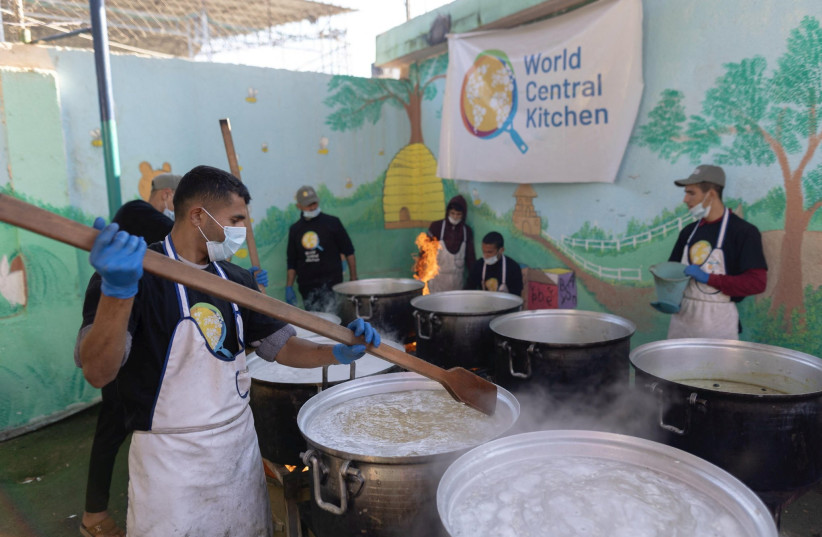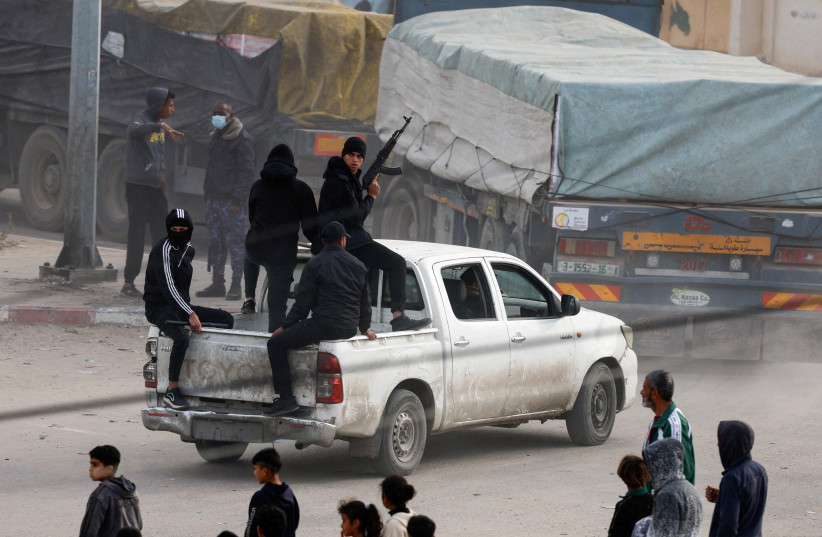Gazans facing nutrition insecurity despite Israel allowing adequate food aid – report
Civilians in Gaza are at risk of food insecurity due to the ongoing Israel-Hamas War, even though Israel has been allowing adequate amounts of food to enter Gaza as humanitarian aid, according to a recent academic working paper.
This was the conclusion reached by a group of researchers from institutions across Israel, including Tel Aviv University, the Hebrew University of Jerusalem, University of Haifa, Ben-Gurion University of the Negev, Sheba Medical Center, Shaare Zedek Medical Center, and the Health Ministry.
The non-peer-reviewed working paper, titled “Nutritional Assessment of Food Aid Delivered to Gaza by land and air drops, during the 2024 War,” was a nutritional assessment of food aid in Gaza, analyzing the quantity of aid and its “compliance with population needs.”
Food insecurity in Gaza during the Israel-Hamas War
Israel has exercised considerable control over what humanitarian aid is allowed to enter the Gaza Strip. However, many experts and policymakers have voiced concern over a humanitarian crisis among Gazan civilians due to Israel’s war against Hamas.
To find out the extent of any food insecurity in Gaza and whether Israel is allowing in enough food aid, the authors carried out their research according to the standards of the Sphere humanitarian guidelines for food security, nutrition, and food aid. This states that everyone has the right to adequate food, which involves “availability of food in a quantity and of a quality sufficient to satisfy the dietary needs of individuals” and “accessibility of such food in ways that are sustainable.”
The Sphere guidelines rule that both states and non-state actors are responsible for fulfilling this obligation (the right to food) and that lack of fulfillment of these obligations is considered a violation of international law.
How much food was allowed into Gaza?
To carry out the assessment, the researchers acquired the registry of all food aid delivered to Gaza via air and land delivery between January-April 2024 from Israel’s Coordinator of Government Activities in the Territories (COGAT).
Unlike the data posted by the United Nations Relief and Works Agency for Palestine Refugees in the Near East (UNRWA), the COGAT data lists the total weight of each aid delivery and its content. COGAT also uses data from multiple sources, both national and private.

For the report, every truck or airdrop of food was categorized, quantified, and assessed in terms of its nutrient composition, according to the reported method. The researchers then determined the energy, protein, fat, and iron content of all shipments, and calculated supply per capita per day, according to the size of Gaza’s population.
These findings were then cross-compared with the Sphere standards for conflict populations.
The assessment found that, in the first quarter of 2024, 14,916 trucks conveying 227,854 tons, and 95 airdrops weighing 3,694 tons of food entered Gaza: an average of 3,729 food trucks per month.
In the same quarter, the weight of food shipments increased by 57%, as did the diversity of food items.
The following food groups were increased: fruit (2,851%), vegetables (2,657%), nuts and seeds (1435%), Dairy and eggs (934%), Potatoes (662%), and chicken, fish, and meat (97%).
The average nutritional energy supplied per say was 3,374 kcal per person, protein was 101 gr (12.1% of energy), fat was 80.6 gr (21.5% of energy), and iron was 25.2 mg. Energy, protein, and fat amounts exceed Sphere recommendations. Iron was lower than the Sphere standard.
Comparing the recommendations of the Sphere Guidelines versus the reported findings, Sphere recommend 2,100 Kcal a day, whereas the average food aid per person in Gaza was reported as 3,374 Kcal. Sphere recommend that 10% of the overall intake should be from protein; the Gaza aid was found to be 12.1% on average.

The iron content in Gazan aid was found to be 25.2 mg a day, lower than the recommended iron of 32 mg a day.
According to the research, even when considering 30% food loss (stolen aid, aid not delivered, or aid left too long to be usable) the theoretical nutrient supply required by a healthy population with the Gazan age distribution would be 2711 kcal, which would still exceed the threshold.
Regarding the low iron, the report acknowledges that this could cause anemia, which is already common in Gaza. The World Bank says “anemia is when the body lacks enough healthy red blood cells to carry oxygen to tissues. It can be caused by a lack of iron and other micronutrients.”
According to sources such as the World Health Organization and the World Bank, anemia is a severe public health problem in Gaza. The World Bank in 2020 reported “over half of pregnant women and over half of children aged 6–23 months were anemic”. The reports came before the war.
The report therefore asks that the “Nutrition and Food Security Clusters encourage humanitarian aid organizations to increase donations of iron-rich food.”
Despite these, the report concluded that: “The quantity and quality of food aid delivered to Gaza have steadily improved since January 2024 and supply sufficient energy, protein, and fat for the population’s needs.”
Challenges to distribution of aid
According to the IDF aid timeline for the final week of May, the aid from Israel was delivered through the Kerem Shalom crossing of the Defense Ministry’s Land Crossing Authority and the Erez crossing. The report also took into account the aid travelling through the Nitzana crossing from Israel to Egypt, where it would head to the Rafah crossing between Egypt and Gaza.
Israel’s governmental guidelines state “there are no restrictions on the admission of humanitarian aid into the Gaza Strip, provided it is coordinated in advance with the Israeli authorities and passes security screening.”
In March 2024, the IPC (Integrated Food Security Phase Classification (IPC) Famine Review Committee (FRC)) predicted that famine would manifest in Gaza between March 2024 and May 2024.
Addressing this prediction, Israel’s report suggests that a famine in Gaza, should it occur, would likely be caused by issues in internal aid distribution in Gaza as Israel’s aid itself.
Once it reaches Gaza, the report says that the aid is at the mercy of various factors, including “theft, looting, and hoarding of food and other supplies, abetted by Hamas or others” which can limit the capacity of Israel to ensure the Gazan population has access to food.

Additionally, Hamas’s attacks on aid crossings, humanitarian zones, or at IDF forces protecting humanitarian corridors can reduce the quantity of aid reaching civilians. The report stated that, the Kerem Shalom crossing was hit by three mortar barrages on May 8, and 16 rocket attacks on the May 5 and 7. The northern pier and humanitarian corridor endured fire throughout May. The study did not account for the aid entering through the US-built sea pier, which sunk last week.
“Delivery alone is not sufficient,” the report concluded, and “ensuring the population’s equitable distribution and access to humanitarian aid requires a sustained cooperative effort.”
Gazan aid, it recommends, must be monitored “from border to consumption.”
“Such a crucial project will require cooperation between Israeli, Palestinian, and international agencies, health practitioners, and researchers, united to ensure the nutritional security of the citizens of Gaza.”





Comments are closed.